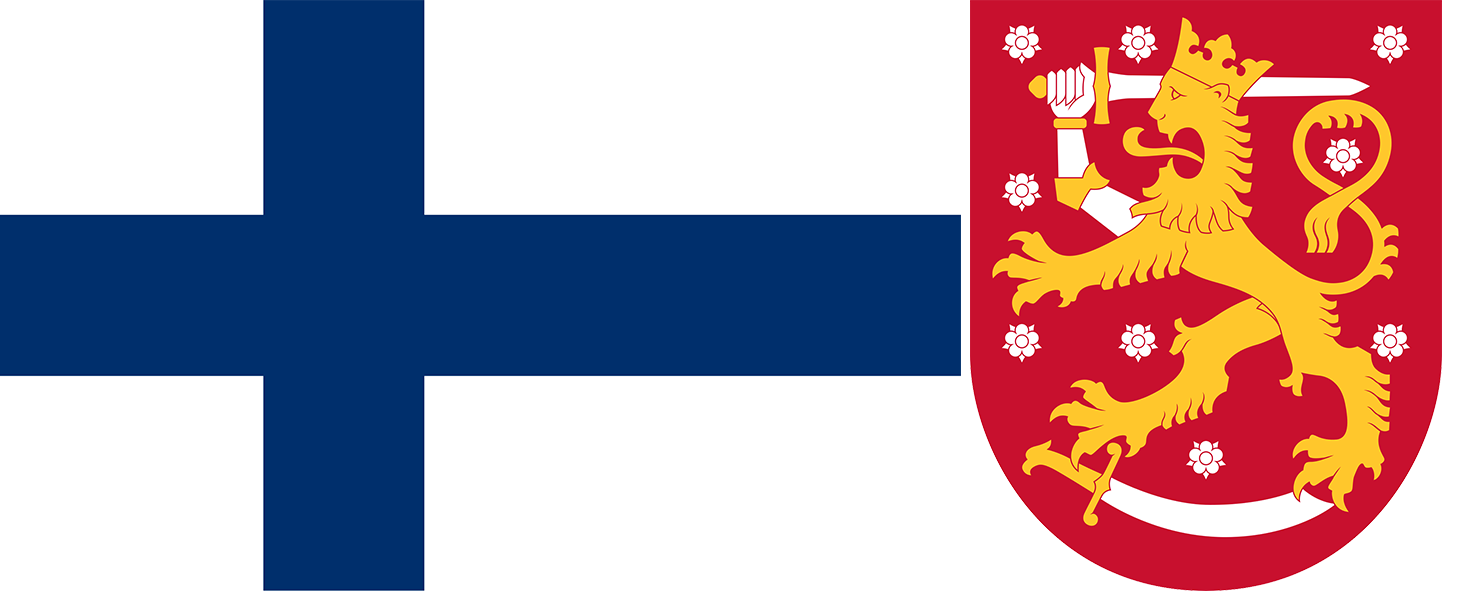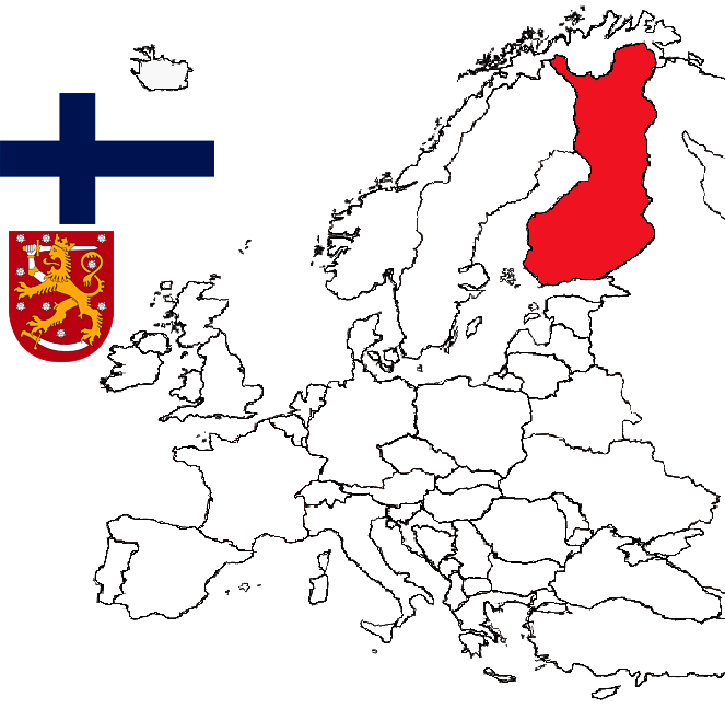FabulousFusionFood's Finnish Recipes Home Page
 The flag of Finland (left) and the coat of arms of Finland (right).
The flag of Finland (left) and the coat of arms of Finland (right).
Welcome to the summary page for FabulousFusionFood's Finnish recipes, part of Europe. This page provides links to all the Finnish recipes presented on this site, with 18 recipes in total.
This is a continuation of an entire series of pages that will, I hope, allow my visitors to better navigate this site. As well as displaying recipes by name, country and region of origin I am now planning a whole series of pages where recipes can be located by meal type and main ingredient. This page gives a listing of all the Indian recipes added to this site.
Finland, officially: Suomen tasavalta (Finnish); Republiken Finland (Swedish) (The Republic of Finland) is a Nordic country in Northern Europe. Helsinki is its capital and largest city and the official languages are Finnish and Swedish (though Sami is recognized as a regional language).
The traditional cuisine of Finland is a mix of European, Nordic and Western Russian and the food is generally simple but freshly prepared. Fish, meat, berries and ground vegetables are typical ingredients whereas spices are not common due to their historical unavailability. But spices have gained importance in modern Finnish cookery and now represent a prominent ingredient in modern Finnish cookery, with influences coming from both East and West.
Finland, officially the Republic of Finland, (Suomen tasavalta in Finnish and Republiken Finland in Swedish) is a Nordic country in Northern Europe. It borders Sweden to the northwest, Norway to the north, and Russia to the east, with the Gulf of Bothnia to the west and the Gulf of Finland to the south, opposite Estonia. Finland covers a total area of 338,145 square kilometres (130,559 sq mi), including a land area of 303,815 square kilometres (117,304 sq mi), and has a population of 5.6 million. Helsinki is the capital and largest city. The vast majority of the population are ethnic Finns. The official languages are Finnish and Swedish; 84.9 percent of the population speak the first as their mother tongue and 5.1 percent the latter. Finland's climate varies from humid continental in the south to boreal in the north. The land cover is predominantly boreal forest biome, with more than 180,000 recorded lakes
 Location of Finland in Europe with the land mass of Finland picked out in red.Finland was first settled around 9000 BC after the last Ice Age. During the Stone Age, various cultures emerged, distinguished by different styles of ceramics. The Bronze Age and Iron Ages were marked by contacts with other cultures in Fennoscandia and the Baltic region. From the late 13th century, Finland became part of Sweden as a result of the Northern Crusades. In 1809, as a result of the Finnish War, Finland was captured from Sweden and became an autonomous grand duchy within the Russian Empire. During this period, Finnish art flourished and the independence movement began to take hold. Finland became the first territory in Europe to grant universal suffrage in 1906, and the first in the world to give all adult citizens the right to run for public office. Following the Russian Revolution of 1917, Finland declared its independence. A civil war was fought in Finland the following year, with the Whites emerging victorious. Finland's status as a republic was confirmed in 1919. During World War II, Finland fought against the Soviet Union in the Winter War and the Continuation War, and later against Nazi Germany in the Lapland War. As a result, it lost parts of its territory but retained its independence.
Location of Finland in Europe with the land mass of Finland picked out in red.Finland was first settled around 9000 BC after the last Ice Age. During the Stone Age, various cultures emerged, distinguished by different styles of ceramics. The Bronze Age and Iron Ages were marked by contacts with other cultures in Fennoscandia and the Baltic region. From the late 13th century, Finland became part of Sweden as a result of the Northern Crusades. In 1809, as a result of the Finnish War, Finland was captured from Sweden and became an autonomous grand duchy within the Russian Empire. During this period, Finnish art flourished and the independence movement began to take hold. Finland became the first territory in Europe to grant universal suffrage in 1906, and the first in the world to give all adult citizens the right to run for public office. Following the Russian Revolution of 1917, Finland declared its independence. A civil war was fought in Finland the following year, with the Whites emerging victorious. Finland's status as a republic was confirmed in 1919. During World War II, Finland fought against the Soviet Union in the Winter War and the Continuation War, and later against Nazi Germany in the Lapland War. As a result, it lost parts of its territory but retained its independence.
Finland remained a largely agricultural country until the 1950s. After World War II, it industrialised quickly and established an advanced economy, with a welfare state built on the Nordic model. This allowed the country to experience overall prosperity and high per capita income.[17] During the Cold War, Finland officially embraced a policy of neutrality. Since then, it has become a member of the European Union in 1995, the Eurozone in 1999, and NATO in 2023. The nation performs exceedingly well in national performance metrics, including education, economic competitiveness, civil liberties, quality of life, and human development.
The name Suomi (Finnish for 'Finland') has uncertain origins, but a common etymology with saame (the Sami) has been suggested. In the earliest historical sources, from the 12th and 13th centuries, the term Finland refers to the coastal region around Turku. This region later became known as Finland Proper in distinction from the country name Finland.
Finland has the world's second highest per capita consumption of coffee. Milk consumption is also high, at an average of about 112 litres, per person, per year, even though 17% of the Finns are lactose intolerant
This is a continuation of an entire series of pages that will, I hope, allow my visitors to better navigate this site. As well as displaying recipes by name, country and region of origin I am now planning a whole series of pages where recipes can be located by meal type and main ingredient. This page gives a listing of all the Indian recipes added to this site.
Finland, officially: Suomen tasavalta (Finnish); Republiken Finland (Swedish) (The Republic of Finland) is a Nordic country in Northern Europe. Helsinki is its capital and largest city and the official languages are Finnish and Swedish (though Sami is recognized as a regional language).
The traditional cuisine of Finland is a mix of European, Nordic and Western Russian and the food is generally simple but freshly prepared. Fish, meat, berries and ground vegetables are typical ingredients whereas spices are not common due to their historical unavailability. But spices have gained importance in modern Finnish cookery and now represent a prominent ingredient in modern Finnish cookery, with influences coming from both East and West.
Finland, officially the Republic of Finland, (Suomen tasavalta in Finnish and Republiken Finland in Swedish) is a Nordic country in Northern Europe. It borders Sweden to the northwest, Norway to the north, and Russia to the east, with the Gulf of Bothnia to the west and the Gulf of Finland to the south, opposite Estonia. Finland covers a total area of 338,145 square kilometres (130,559 sq mi), including a land area of 303,815 square kilometres (117,304 sq mi), and has a population of 5.6 million. Helsinki is the capital and largest city. The vast majority of the population are ethnic Finns. The official languages are Finnish and Swedish; 84.9 percent of the population speak the first as their mother tongue and 5.1 percent the latter. Finland's climate varies from humid continental in the south to boreal in the north. The land cover is predominantly boreal forest biome, with more than 180,000 recorded lakes
 Location of Finland in Europe with the land mass of Finland picked out in red.
Location of Finland in Europe with the land mass of Finland picked out in red.Finland remained a largely agricultural country until the 1950s. After World War II, it industrialised quickly and established an advanced economy, with a welfare state built on the Nordic model. This allowed the country to experience overall prosperity and high per capita income.[17] During the Cold War, Finland officially embraced a policy of neutrality. Since then, it has become a member of the European Union in 1995, the Eurozone in 1999, and NATO in 2023. The nation performs exceedingly well in national performance metrics, including education, economic competitiveness, civil liberties, quality of life, and human development.
The name Suomi (Finnish for 'Finland') has uncertain origins, but a common etymology with saame (the Sami) has been suggested. In the earliest historical sources, from the 12th and 13th centuries, the term Finland refers to the coastal region around Turku. This region later became known as Finland Proper in distinction from the country name Finland.
Food and Cuisine:
Finnish cuisine generally combines traditional country fare and contemporary style cooking. Potato, meat and fish play a prominent role in traditional Finnish dishes. Finnish foods often use wholemeal products (rye, barley, oats) and berries (such as bilberries, lingonberries, cloudberries, and sea buckthorn). Milk and its derivatives like buttermilk are commonly used as food and drink. The most popular fish food in Finland is salmonFinland has the world's second highest per capita consumption of coffee. Milk consumption is also high, at an average of about 112 litres, per person, per year, even though 17% of the Finns are lactose intolerant
The alphabetical list of all the Finnish recipes on this site follows, (limited to 100 recipes per page). There are 18 recipes in total:
Page 1 of 1
| Hernekeitto (Finnish Pea and Ham Soup) Origin: Finland | Lohikeitto (Finnish Salmon Soup) Origin: Finland | Puolukkahillo (Finnish Lingonberry Jam) Origin: Finland |
| Jõulune aprikoosikissell vahukoorega (Apricot and Mulled Wine Fruit Soup) Origin: Finland | Luumuhilloa (Finnish Prune Jam) Origin: Finland | Raparperi ja Spruce Vihje juoma (Rhubarb and Spruce Tip Drink) Origin: Finland |
| Karelian Lanttukukko (Karelian Pie) Origin: Finland | Maitohorsmia Hytelö (Fireweed Jelly) Origin: Finland | Sea-buckthorn Pudding Origin: Finland |
| Karjalanpaisti (Karelian Stew) Origin: Finland | Mustikkapiirakka (Finnish Bilberry Pie) Origin: Finland | Sienimunaskas-kääryle (Wild Mushroom Omelette Roll) Origin: Finland |
| Lakka Keitto (Cloudberry Soup) Origin: Finland | Pihlajanmarjahyytelö (Finnish Rowanberry Jelly) Origin: Finland | Suomalaisruisleipa (Finnish Rye Bread) Origin: Finland |
| Lakkahyytelö (Finnish Cloudberry Jelly) Origin: Finland | Pulla (Finnish Sweet Cardamom Raisin Bread) Origin: Finland | Suomen Kalakeitto (Finnish Fish Soup) Origin: Finland |
Page 1 of 1